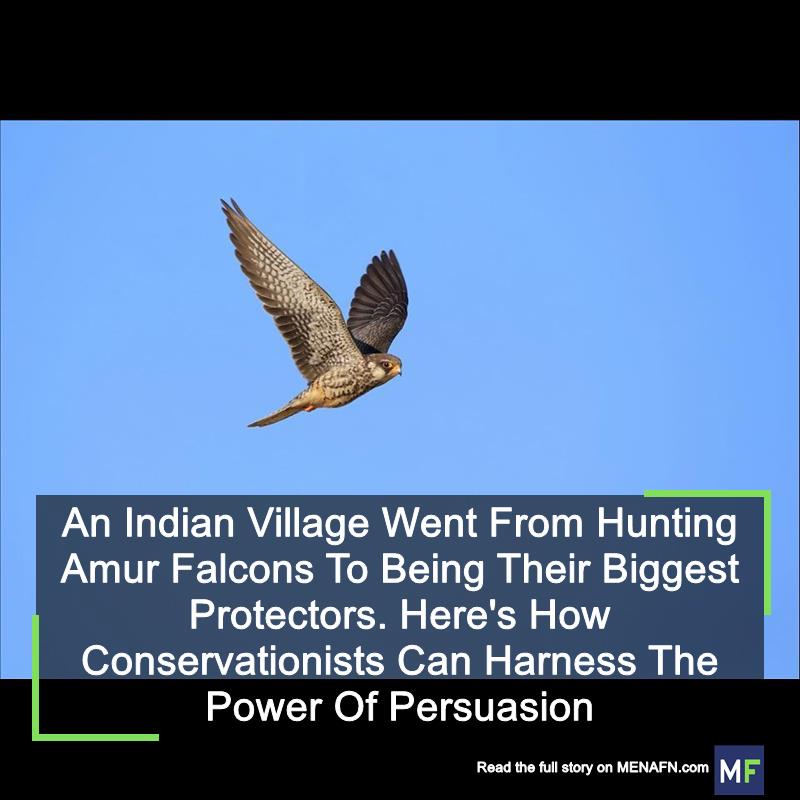
An Indian Village Went From Hunting Amur Falcons To Being Their Biggest Protectors. Here's How Conservationists Can Harness The Power Of Persuasion
Influencing human behaviour to benefit nature is hard, but it can be done . In the case of the Amur falcon, we found that legislation and enforcement were successful at stopping hunting of this migratory raptor and maintaining changes in hunting practices. But the key to success involved fostering local pride in the bird, alongside providing economic incentives.
The Amur falcon is a bird the size of an apple with a yearly commute from Siberia to Africa and back – the equivalent in total to six trips from London to New York. One key stop in the bird's journey is the forests of Nagaland in north-east India.
Since its construction in 2000, an artificial reservoir over Nagaland's Doyang river has attracted vast numbers of winged termites – in turn increasing the number of Amur falcons stopping to feed on these insects . As the numbers of falcons rose, they became very easy targets for local hunters, for whom wildlife hunting is an integral part of their traditional culture. These birds were hunted for food as well as traded in local markets, earning significant seasonal revenue for the hunters.
Thousands of Amur falcons migrate through Nagaland, North India. Mike Prince
Fast-forward to November 2012. The scale of the hunt at Doyang reservoir, particularly in Pangti village, came to the attention of conservationists like us, who estimated that between 120,000 and 140,000 birds (about 10% of the global adult population) were being caught in only ten days. These birds stopped at the Doyang reservoir to fatten up before their migration to Africa, but were trapped using fishing nets hung across trees.
A global media campaign was spearheaded by the environmental charity Conservation India . A hard-hitting short film , The Amur Falcon Massacre, was shared online to show the true horror and scale of this hunt. Conservationists tried to leverage India's membership of the Convention on Migratory Species , and such pressure led to the Indian government making a global commitment to protect species including the Amur falcon.
The government took swift action. It warned Pangti villagers that unless the hunting stopped, it would cut off funding for crucial development projects. Faced with this threat, the village council imposed a ban on hunting falcons in 2013 – without consulting the broader community.
That decision was deeply unpopular with local villagers. Falcon hunting had been an important source of income, and many villagers were resistant to the ban. Though the hunting stopped, local trust in the council leadership was low because the ban was seen as authoritarian.
However, the decision was backed by financial incentives and environmental outreach from charitable organisations and the government's forest department. This helped reframe the falcons as“honoured guests”, and to connect local people more empathetically with the birds. Hunting was actively discouraged; eventually, it ceased altogether.
An Amur falcon (Falco amurensis) in flight. Touhid biplob/Wikimedia , CC BY-NC-ND
By 2017, a sense of pride began to grow within the community . Awards and recognition from external bodies, including the Indian government, for Pangti's conservation efforts helped create a positive image of the village worldwide. The community's emotional bond with the falcons strengthened. Villagers even held prayers for satellite-tagged falcons before releasing them. Falcon conservation became a symbol of local identity and pride, which helped overcome the initial resistance to the hunting ban.
This allowed conservation measures to expand. The community outlawed air guns to prevent the hunting of small birds, and extended the hunting ban to cover all wildlife for six months of the year. These actions showed the community wasn't just enforcing government rules; it was actively creating new conservation initiatives of its own.
The power of persuasionHuman actions drive biodiversity outcomes . These can be destructive, like poaching, or protective, like community-led conservation. The end of the indiscriminate killing of the Amur falcon in Nagaland highlights that, while behaviour change can take place in a short period, maintaining it over the long term is often much more challenging.
For instance, while the initial ban was effective in quickly eliminating hunting, the shift from resistance to pride in falcon conservation took years to fully develop. Sustaining this change has required continuous community engagement and building of pride in the species.
Visual storytelling – in this case, a film widely shared on social media – can also play a powerful role in turning local issues into global ones. The international attention brought to the unsustainable hunting of the Amur falcon was instrumental in prompting government action. This shows how global media exposure can elevate a local conservation issue, creating a sense of urgency that compels authorities to act.
However, while media campaigns can quickly drive policy changes, they don't always lead to lasting behaviour change. Campaigns that rely on shock and urgency may alienate local communities, creating resistance.
Sustainable behaviour change requires building trust, understanding local values, and supporting community leadership. True change happens when people feel empowered and see benefits from their actions – not simply when they feel pressured to comply.
Don't have time to read about climate change as much as you'd like?
Get a weekly roundup in your inbox instead. Every Wednesday, The Conversation's environment editor writes Imagine, a short email that goes a little deeper into just one climate issue. Join the 40,000+ readers who've subscribed so far.

Legal Disclaimer:
MENAFN provides the
information “as is” without warranty of any kind. We do not accept
any responsibility or liability for the accuracy, content, images,
videos, licenses, completeness, legality, or reliability of the information
contained in this article. If you have any complaints or copyright
issues related to this article, kindly contact the provider above.


















Comments
No comment